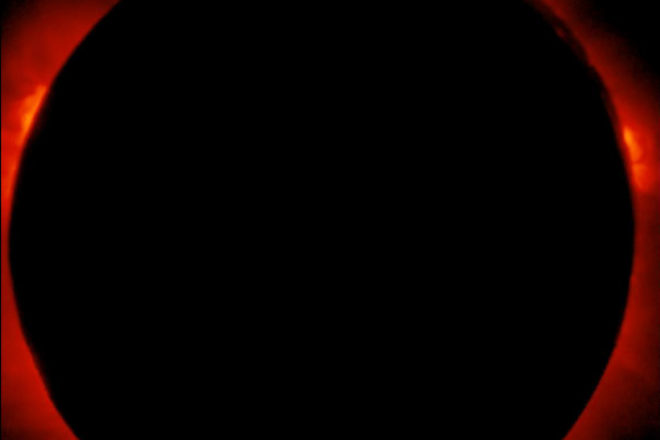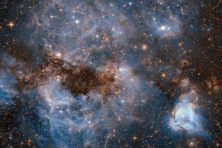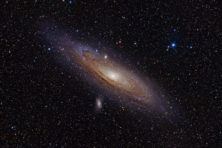Eye On the Night Sky: The Earth’s Moon – Full of Surprises
- Share
- Tweet
- Pin
- Share

by Gary Henkelmann, President, Door Peninsula Astronomical Society
On Aug. 21, the moon will pass between the sun and the Earth, partially obscuring the sun over the entire North American continent for several hours, and totally covering the solar disk for a couple of minutes along a narrow, 90 mile-wide path from Oregon to South Carolina. The event will be headline news here in the United States, but it’s not likely to even raise eyebrows elsewhere, as eclipses of the sun occur several times each year, and unless you’re in the direct path of the event it won’t affect you at all. Even in Door County, on Aug. 21, most of us may not notice the darkening of the sky during the middle of the day unless we’re paying attention and recognize what the cause is. Of course, that cause is the moon.
We learned in last month’s “Eye on the Night Sky” column that the moon was first determined (2,200 years ago) to be about 38 percent the size of the Earth, later refined to 27 percent, which makes it the largest moon/planet ratio in the Solar System. There are larger moons, consisting of, in order, Ganymede (Jupiter), Titan (Saturn), Callisto, and Io (both Jupiter), but they’re only 2.6 to 4.4 percent as large as the planet they orbit. The highest ratio next to our moon goes to Neptune’s Triton at 5.4 percent, so by a factor of 5 our moon eclipses all others for its ability to cast a shadow on its host.
A second and subtle feature of our moon is that its orbit around the Earth does not coincide with the Earth’s orbit around the sun. The plane of the moon’s orbit is tilted 5.1 degrees to the “Ecliptic” upon which the Earth circulates. This does not seem like much, but in order to explain the frequency of solar (and lunar) eclipses, we need to appreciate how the size of the moon, the distance of its orbit from the Earth, and this angle of tilt all combine to produce a low likelihood of the moon’s shadow contacting the Earth each month. The moon’s 2,100-mile diameter has to pass inside of the Earth’s 8,000-mile height as it passes in front of the sun to cast a shadow, and given that it could be 21,000 miles above or below the Ecliptic in its orbit at the time, the odds of doing so are about 1 in 5.
Another feature of the moon is that it orbits the Earth in an elliptical path, one which is not too pronounced, but it does make the moon appear up to 17 percent larger or smaller, from Perigee (225,000 MI) to Apogee (250,000 MI). The timing of this in relation to an eclipse will determine whether or not the moon can totally block sunlight at the ground. If it can, a total eclipse may occur, and if it can’t, an annular eclipse may occur.
The sizes and distances of both the sun and the moon relative to the Earth are uniquely positioned so as to make it possible for the moon to just totally block all the light from the sun, or not quite block all the light, depending upon how close the moon is to Earth. Someday, because the moon is slowly moving farther from the Earth, total eclipses will no longer occur. In the meantime, we can enjoy the variety of eclipses, and complexity of movement that our unique satellite has to offer.
Upcoming Solar Eclipse Events
The Door Peninsula Astronomical Society meets Tuesday, Aug. 1 at 7 pm at the Stonecipher Astronomy Center, 2200 Utah St., Sturgeon Bay, featuring: a photographic review of the 1994 solar eclipse over Chicago; a presentation on how stars are grouped by type and size; and an update on exo-planets and why we are not finding any around some stars. The meeting is open to the public and refreshments will be served. Visit doorastronomy.org for more information.
DPAS will also lead special Solar Eclipse Telescope Viewing tutorial sessions at the Sturgeon Bay Library (Aug. 16 at 5:30 pm) and Sister Bay Library (Aug. 17 at 11 am) to demonstrate the safe use of the library telescopes with their newly acquired solar filters that patrons can check out for eclipse and sunspot viewing.
Public viewing of the Aug. 21 solar eclipse will be hosted at the Astronomy Center, beginning at 11 am with live projection of the eclipse from the Leif Everson Observatory as well as other sites across the country where the total eclipse will be seen. Solar eclipse glasses will be available for visitors’ use.





